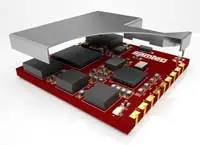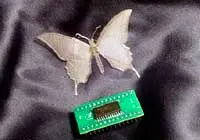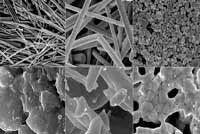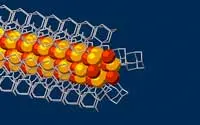Electronics News
Archive : 7 January 2017 год
 A wireless sensor module developed by Samtec and STMicroelectronics is said to be a production-ready solution that allows engineers to sense and measure inertial, environmental and acoustical parameters remotely.
A wireless sensor module developed by Samtec and STMicroelectronics is said to be a production-ready solution that allows engineers to sense and measure inertial, environmental and acoustical parameters remotely.
Measuring 13.5mm x 13.5mm, the module contains an accelerometer, gyroscope, magnetometer, pressure sensor and microphone – parts developed by STMicroelectronics. Its size is said to make the module suitable for use as a standalone node in such products as wearables, gaming accessories and smart home or IoT devices.
Alongside the sensors, the moduel features an STM32L476 MCU with a floating point unit, Bluetooth LE communications and a low noise low drop out regulator.
Effectively, says Samtec, the module is an FCC certified production version of ST’s SensorTile development kit and is compatible with the STM32 ecosystem through STM32Cube support.
“The cooperation between Samtec and ST is expanding the functionality of ST’s SensorTile from development to production,” said Steve Hillerich, Samtec’s product manager, modules. “Samtec’s modular approach to IoT application development is leveraging ST’s IoT development ecosystem to enable OEMs to focus on their core IoT application competencies. With the continued growth of wireless sensing and connectivity, Samtec’s nMode module shortens design cycles and time to market for IoT application developers.”
Using its Glass Core Technology, Samtec plans to release smaller versions of the nMode module, as well as further standard nMode modules, in 2017.
Author
Graham Pitcher
Source: www.newelectronics.co.uk
 A process developed by KAUST prints silicon-based networked sensors on to soft, sticker-like surfaces that can be attached anywhere. Pressure-sensitive ‘e-stickers’ contain all the functionality of traditional silicon circuits, but can be fabricated into complex, flexible shapes such as butterflies.
A process developed by KAUST prints silicon-based networked sensors on to soft, sticker-like surfaces that can be attached anywhere. Pressure-sensitive ‘e-stickers’ contain all the functionality of traditional silicon circuits, but can be fabricated into complex, flexible shapes such as butterflies.
Flexible printed circuits require conventional silicon components to handle applications such as digitising analogue signals. According to the research team, such rigid modules can create hot spots on the body and increase device weight.
“We are trying to integrate all device components-sensors, data management electronics, battery, antenna-into a completely compliant system,” explained scientist Muhammad Hussain. “However, packaging these discrete modules on to soft substrates is difficult.”
Searching for potential electronic skin applications, the researchers developed a sensor containing narrow strips of aluminium foil that changes conductivity at different bending states.
The device, which could monitor a patient’s breathing patterns or activity levels, features high mobility zinc oxide nanotransistors on silicon wafers thinned down lithographically to microscale dimensions for maximum flexibility. Using 3D printing techniques, the team encapsulated the silicon chips and foils into a polymer film backed by an adhesive layer.
The researchers found a way to make the e-sticker sensors work in multiple applications. They used inkjet printing to write conductive wiring patterns on to different surfaces, such as paper or clothing. Custom-printed decals were then attached or re-adhered to each location.
“You can place a pressure-sensing decal on a tire to monitor it while driving and then peel it off and place it on your mattress to learn your sleeping patterns,” said PhD graduate Galo Torres Sevilla.
The team claim the robust performance and manufacturing potential of decal electronics could launch a number of innovative sensor deployments.
Author
Peggy Lee
Source: www.newelectronics.co.uk
 Renesas Electronics has unveiled a series of MCUs intended for use with automotive radar systems. The RH850 based parts are said by the company to deliver the performance and features required for future advanced driver assistance systems (ADAS) and autonomous driving vehicles.
Renesas Electronics has unveiled a series of MCUs intended for use with automotive radar systems. The RH850 based parts are said by the company to deliver the performance and features required for future advanced driver assistance systems (ADAS) and autonomous driving vehicles.
Looking to address a range of needs, Renesas has launched the RH850/V1R-M MCU. The part includes an optimised DSP, a dual core running at 320MHz, 2Mbyte of flash and 2Mbyte of RAM. It is also said to meet the industry’s highest temperature requirements, with a junction temperature of 150°C.
The DSP performs radar specific algorithms, such as fast Fourier transforms, beamforming, windowing, channel calibration and peak search. These are accomplised at high speed and with low power consumption.
The MCU features two G3MH CPU cores operating at 320MHz, said to be the highest performing cores in the RH850 Family. The G3MH has two seven stage integer pipelines, allowing execution of two instructions simultaneously. Each core has a performance of 3.2DMIPS/MHz.
Targeted at Renesas’ 40nm embedded flash process technology, samples will be available in the second half of 2017 and mass production is scheduled to begin in November 2018.
Author
Graham Pitcher
Source: www.newelectronics.co.uk
 By suspending tiny metal nanoparticles in liquids, Duke University scientists are creating conductive ‘inks’ that can be used to print inexpensive, customisable circuit patterns on any surface.
By suspending tiny metal nanoparticles in liquids, Duke University scientists are creating conductive ‘inks’ that can be used to print inexpensive, customisable circuit patterns on any surface.
According to the researchers, printed electronics currently have one major drawback: for the circuits to work, they first have to be heated to melt all the nanoparticles together into a single conductive wire.
Duke researchers show that changing the shape of the nanoparticles in the ink might eliminate the need for heat.
By comparing the conductivity of films made from different shapes of silver nanostructures, the team found that electrons cross films made of silver nanowires more easily than films made from other shapes, such as nanospheres or microflakes.
"The nanowires had a 4000 times higher conductivity than the more commonly used silver nanoparticles that you would find in printed antennas for RFID tags," said assistant professor Benjamin Wiley. "So if you use nanowires, you don't have to heat the printed circuits up to such high temperature and you can use cheaper plastics or paper."
The scientists mixed the nanostructures with distilled water to make simple ‘inks’. By adding a precise volume of ink into each tape ‘well’ and then heating the wells – either to relatively low temperature to simply evaporate the water or to higher temperatures to begin melting the structures together – they created a variety of films to test.
"The resistivity of the long silver nanowire films is several orders of magnitude lower than silver nanoparticles and only 10 times greater than pure silver," graduate student Ian Stewart said.
As well as smart packaging, the researchers envision using the technology to make solar cells, printed displays, LEDS, touchscreens, amplifiers, batteries and implantable bio-electronic devices.
The team is now experimenting with using aerosol jets.
Author
Peggy Lee
Source: www.newelectronics.co.uk
 Scientists at Stanford University and the US Department of Energy’s SLAC National Accelerator Laboratory have discovered a way to use diamondoids – the smallest possible bits of diamond – to assemble atoms into electrical wires just three atoms wide.
Scientists at Stanford University and the US Department of Energy’s SLAC National Accelerator Laboratory have discovered a way to use diamondoids – the smallest possible bits of diamond – to assemble atoms into electrical wires just three atoms wide.
The technique could potentially be used to build wires for a range of applications, including fabrics that generate electricity, optoelectronic devices that employ both electricity and light, and superconducting materials that conduct electricity without loss.
“What we have shown here is that we can make tiny, conductive wires that essentially assemble themselves,” said Hao Yan, a Stanford postdoctoral researcher. “The process is a simple, one-pot synthesis. You dump the ingredients together and you can get results in half an hour.”
According to the researchers, although there are other ways to get materials to self-assemble, this is the first one shown to make a nanowire with a solid, crystalline core that has good electronic properties.
For this study, the research team started with the smallest possible diamondoids – single cages that contain 10 carbon atoms – and attached a sulphur atom to each. Floating in a solution, each sulphur atom bonded with a single copper ion. This created the basic nanowire building block.
“Much like LEGO blocks, they only fit together in certain ways that are determined by their size and shape,” said Stanford graduate student Fei Hua Li. “The copper and sulphur atoms of each building block wound up in the middle, forming the conductive core of the wire, and the bulkier diamondoids wound up on the outside, forming the insulating shell.”
The team has already used diamondoids to make one-dimensional nanowires based on cadmium, zinc, iron and silver.
“You can imagine weaving them into fabrics to generate energy,” said Nicholas Melosh, an associate professor at SLAC and Stanford. “This method gives us a versatile toolkit where we can tinker with a number of ingredients and experimental conditions to create new materials with finely tuned electronic properties and interesting physics.”
Author
Peggy Lee
Source: www.newelectronics.co.uk

